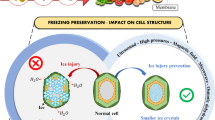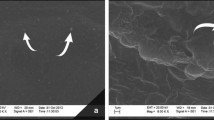Abstract
The effects of pressure (21.3, 41.3, 61.3, 81.3, and 101.3 kPa) and temperature (174–184 °C) applied during the post-frying centrifuge stage on the physico-chemical characteristics of atmospheric fried plantain chips were studied. Results showed that the surface temperature dropped very fast during the cooling process while the total oil content gradually increased. The oil uptake in the plantain chips increased by 7.7% after 9 min of post-frying cooling. Though an alteration in moisture and oil content was significantly affected (p < 0.05) by either vacuum pressure or temperature control applied during the post-frying centrifuge step, a higher reduction (p < 0.05) of moisture content by 79.1% and total oil content by 44.9% was observed when the combination of vacuum pressure (21.3 kPa) and temperature control was employed, comparing to the control of atmospheric pressure (101.3 kPa). Plantain chips centrifuged under vacuum pressure at 21.3 kPa without temperature control had higher total extractable phenolic acids and lower acrylamide content when compared to control sample. A reduction of pressure alone produced lighter color, higher crispness, and less volume shrinkage of plantain chips; however, no significant difference (p > 0.05) was observed among the samples centrifuged at different pressures. The application of vacuum pressure at 21.3 kPa together with temperature control for 5 min during the post-frying centrifuge stage was significantly effective (p < 0.05) in reducing moisture and oil content, while samples were less crispiness, shrunk more, and a higher bulk density.





Similar content being viewed by others
Data availability
The data used to support the findings in this study are included within the article.
References
Y. Zhang, T. Zhang, D. Fan, J. Li, L. Fan, The description of oil absorption behavior of potato chips during the frying. LWT-Food Sci. Technol. 96, 119–126 (2018)
Y. Liu, J. Tian, T. Zhang, L. Fan, Effects of frying temperature and pore profile on the oil absorption behavior of fried potato chips. Food Chem. 345, 128832 (2021)
S. Devi, M. Zhang, R. Ju, B. Bhandari, Water loss and partitioning of the oil fraction of mushroom chips using ultrasound-assisted vacuum frying. Food Biosci. 38, 100753 (2020)
P. Bouchon, D.L. Pyle, Studying oil absorption in restructured potato chips. J. Food Sci. 69, 115–122 (2004)
J. Zhang, L. Fan, Effects of preliminary treatment by ultrasonic and convective air drying on the properties and oil absorption of potato chips. Ultrason. Sonochem. 74, 105548 (2021)
M. Durán, F. Pedreschi, P. Moyano, E. Troncoso, Oil partition in pre-treated potato slices during frying and cooling. J. Food Eng. 81, 257–265 (2007)
L.E. Cahill, A. Pan, S.E. Chiuve, Q. Sun, W.C. Willett, F.B. Hu, E.B. Rimm, Fried-food consumption and risk of type 2 diabetes and coronary artery disease: a prospective study in 2 cohorts of US women and men. Am. J. Clin. Nutr. 100, 667–675 (2014)
T.V. Gadiraju, Y. Patel, J.M. Gaziano, L. Djoussé, Fried food consumption and cardiovascular health: a review of current evidence. Nutrients 7, 8424–8430 (2015)
J. Dehghannya, L. Abedpour, Influence of a three stage hybrid ultrasound-osmotic-frying process on production of low-fat fried potato strips. J. Sci. Food Agric. 98(4), 1485–1491 (2018)
M.C. Moreno, P. Bouchon, A different perspective to study the effect of freeze, air, and osmotic drying on absorption during potato frying. J. Food Sci. 73, E122–E128 (2008)
B. Jia, D. Fan, L. Yu, J. Li, Z. Duan, L. Fan, Oil absorption of potato slices pre-dried by three kinds of methods. Eur. J. Lipid Sci. Technol. 120(6), 1700382 (2018)
M. Kurek, M. Ščetar, K. Galić, Edible coatings minimize fat uptake in deep fat fried products: a review. Food Hydrocoll. 71, 225–235 (2017)
J. Mir-Bel, R. Oria, M.L. Salvador, Influence of the vacuum break conditions on oil uptake during potato post-frying cooling. J. Food Eng. 95(3), 416–422 (2009)
C. Primo-Martin, H. van Deventer, Deep-fat fried battered snacks prepared using super heated steam (SHS): crispiness and low oil content. Food Res. Int. 44(1), 442–448 (2011)
Y. Su, M. Zhang, B. Chitrakar, W. Zhang, Reduction of oil uptake with osmotic dehydration and coating pre-treatment in microwave-assisted vacuum fried potato chips. Food Biosci. 39, 100825 (2021)
R. Moreira, P. Da Silva, C. Gomes, The effect of a de-oiling mechanism on the production of high-quality vacuum fried potato chips. J. Food Eng. 92, 297–304 (2009)
D.B. He, F. Xu, T.C. Hua, A.Y. Song, Oil absorption mechanism of fried food during cooling process. J. Food Proc. Eng. 21, 412–417 (2013)
Y. Karademir, V. Gökmen, H.M. Öztop, Investigation of lipid-derived formation of decadiene-1-amine, 2-pentylpyridine, and acrylamide in potato chips fried in repeatedly used sunflower oil. Food Res. Int. 121, 919–925 (2019)
S.L. Kuek, A.H.A. Tarmizi, R.A. Razak, S. Jinap, S. Norliza, M. Sanny, Contribution of lipid towards acrylamide formation during intermittent frying of French fries. Food Control 118, 107430 (2020)
J.G. Hogervorst, L.J. Schouten, E.J. Konings, R.A. Goldbohm, P.A. van den Brandt, Dietary acrylamide intake and the risk of renal cell, bladder, and prostate cancer. Am. J. Clin. Nutr. 87(5), 1428–1438 (2008)
C. Rannou, D. Laroque, E. Renault, C. Prost, T. Sérot, Mitigation strategies of acrylamide, furans, heterocyclic amines and browning during the Maillard reaction in foods. Food Res. Int. 90, 154–176 (2016)
C. Gertz, S. Klostermann, Analysis of acrylamide and mechanisms of its formation in deep fried products. Eur. J. Lipid Sci. Technol. 104(11), 762–771 (2002)
Y. Wang, H. Hu, D.J. McClements, S. Nie, S. Shen, C. Li, Y. Huang, Y. Zhong, J. Chen, M. Zeng, M. Xie, pH and lipid unsaturation impact the formation of acrylamide and 5-hydroxymythylfurfural in model system at frying temperature. Food Res. Int. 123, 403–413 (2019)
N. Watzek, M. Baum, F. Berger, G. Eisenbrand, J. Feld, U. Fuhr, D. Tomalik-Scharte, E. Richling, Exposure to acrolein exceeds that to acrylamide: monitoring mercapturic acids in human urine after consumption of potato crisps. Toxicol. Lett. 205, S77 (2011)
FDA (Food and Drug Administration), Guidance for Industry Acrylamide in Foods (2016), https://www.fda.gov/media/87150/download. Accessed 6 July 2021
F. Mestdagh, T. De Wilde, K. Delporte, C. Van Peteghem, B. De Meulenaer, Impact of chemical pre-treatments on the acrylamide formation and sensorial quality of potato crisps. Food Chem. 106(3), 914–922 (2008)
F. Pedreschi, R.N. Zuñiga, Acrylamide and oil reduction in fried potatoes: a review. Glob. Sci. Books 2, 82–92 (2009)
R. Medeiros-Vinci, F. Mestdagh, C. Van Poucke, B. Kerkaert, N. De Muer, Q. Denon, C. Van Peteghem, B. De Meulenaer, Implementation of acrylamide mitigation strategies on industrial production of French fries: challenges and pitfalls. J. Agric. Food Chem. 59(3), 898–906 (2011)
E. Rottmann, K.F. Hauke, U. Krings, R.G. Berger, Enzymatic acrylamide mitigation in French fries: an industrial-scale case study. Food Control 123, 107739 (2021)
C.P. Passos, S.S. Ferreira, A. Serodio, E. Basil, L. Marková, K. Kukurová, Z. Ciesarová, M.A. Coimbra, Pectic polysaccharides as an acrylamide mitigation strategy: competition between reducing sugars and sugar acids. Food Hydrocoll. 81, 113–119 (2018)
I. Nachi, I. Fhoula, I. Smida, I. Ben Taher, M. Chouaibi, J. Jaunbergs, V. Bartkevics, M. Hassouna, Assessment of lactic acid bacteria application for the reduction of acrylamide formation in bred. LWT-Food Sci. Technol. 92, 435–441 (2018)
A. Antunes-Rohling, S. Ciudad-Hidalgo, J. Mir-Bel, J. Raso, G. Cebrián, I. Álvarez, Ultrasound as a pretreatment to reduce acrylamide formation in fried potatoes. Innov. Food Sci. Emerg. Technol. 49, 158–169 (2018)
F. Pedreschi, A. Ferrera, A. Bunger, F. Alvarez, N.L. Huamán-Castilla, M.S. Mariotti-Celis, Ultrasonic-assisted leaching of glucose and fructose as an alternative mitigation technology of acrylamide and 5-hydroxymethylfurfural in potato chips. Innov. Food Sci. Emerg. Technol. (2021). https://doi.org/10.1016/j.ifset.2021.102752
X.T. Zhang, M. Zhang, B. Adhikari, Recent developments in frying technologies applied to fresh foods. Trends Food Sci. Technol. 98, 68–81 (2020)
E. De Langhe, M. Pillay, A. Tenkouano, R. Swennen, Integrating morphological and molecular taxonomy in Musa: the African plantains (Musa spp. AAB group). Plant Syst. Evol. 255, 225–236 (2005)
P. Udomkun, C. Masso, R. Swennen, T. Wossen, D. Amah, A. Fotso, J. Lienou, M. Adesokan, E. Njukwe, B. Vanlauwe, Variability of provitamin A carotenoids in plantain: influence of cultivar, bunch type, maturation stage, and location. J. Food Compos. Anal. 94, 103636 (2020)
AOAC, Official Methods of Analysis, 15th ed, (Arlington, Virginia, USA: Association of Official Analytical Chemists AOAC) (1990)
K.H. Kim, R. Tsao, R. Yang, S.W. Cui, Phenolic acid profile and antioxidant activities of wheat bran extracts and the effect of hydrolysis conditions. Food Chem. 95, 466–473 (2006)
L. Shamla, P. Nisha, Acrylamide formation in plantain (Musa paradisiaca) chips influenced by different ripening stages: a correlation study with respect to reducing sugars, amino acids and phenolic content. Food Chem. 222, 53–60 (2017)
J. Zhang, T. Xie, L. Fan, Improving the quality and reducing oil absorption of fried potato chips by ultrasound pretreatment. LWT-Food Sci. Technol. 148, 111763 (2021)
Y. Su, M. Zhang, B. Chitrakar, W. Zhang, Effects of low-frequency ultrasonic pre-treatment in water/oil medium simulated system on the improved processing efficiency and quality of microwave-assisted vacuum fried potato chips. Ultrason. Sonochem. 63, 104958 (2020)
J. Garayo, R. Moreira, Vacuum frying of potato chips. J. Food Eng. 55(2), 181–191 (2002)
P. Cortés, L. Segura, M. Kawaji, P. Bouchon, The effect of gravity on moisture loss and oil absorption profiles during a simulated frying process using glass micro models. Food Bioprod. Process. 95, 133–145 (2015)
E. Troncoso, F. Pedreschi, Modelling water loss and oil uptake during vacuum frying of pre-treated potato slices. LWT-Food Sci. Technol. 42(6), 1164–1173 (2009)
F.B. Apeh-Bah, J.C. Serem, M.J. Bester, K.G. Duodu, Phenolic composition and antioxidant properties of koose, a deep-fat fried cowpea cake. Food Chem. 237, 247–256 (2017)
A. Ruiz, A. Aguilera, S. Ercoli, J. Parada, P. Winterhalter, B. Contreras, P. Cornejo, Effect of the frying process on the composition of hydroxycinnamic acid derivatives and antioxidant activity in flesh colored potatoes. Food Chem. 268, 577–584 (2018)
P.F. Da Silva, R.G. Moreira, Vacuum frying of high-quality fruit and vegetable-based snacks. LWT-Food Sci. Technol. 41(10), 1758–1767 (2008)
M. Granito, B. Yannellis, A. Torres, Chemical composition, antioxidant capacity and functionality of raw and processed Phaseolus lunatus. J. Sci. Food Agric. 87, 2801–2809 (2007)
H. Lingnert, S. Grivas, M. Jägerstad, K. Skog, M. Törnqvist, P. Åman, Acrylamide in food: mechanisms of formation and influencing factors during heating of foods. Scand. J. Nutr. 46(4), 159–172 (2002)
H.T. Hsu, M.J. Chen, T.P. Tseng, L.H. Cheng, L.J. Huang, T.S. Yeh, Kinetics for the distribution of acrylamide in French fries, fried oil and vapour during frying of potatoes. Food Chem. 211, 669–678 (2016)
F. Pedreschi, K. Kaack, K. Granby, Acrylamide content and color development in fried potato strips. Food Res. Int. 39(1), 40–46 (2006)
M. Mesias, C. Delgado-Andrade, F. Holgado, L. González-Mulero, F.J. Morales, Effect of consumer’s decision on acrylamide exposure during the preparation of French fries. Part 2: color analysis. Food Chem. Toxicol. 154, 112321 (2021)
Acknowledgements
This work was carried out through financial support from the African Union Research Grants, Reference: HRST/ST/AURG-II/CALL2/2018 via a project titled “Enhancing nutritional quality of plantain food products through improved access to endophyte primed and high provitamin A plantain cultivars under integrated soil fertility management practices in Nigeria, Cameroon, and Gabon” to the International Institute of Tropical Agriculture. The authors are also grateful to the Department of Food Technology, Faculty of Engineering and Industrial Technology, Silpakorn University, for their technical supports. The authors are grateful to all donors who supported this work through their contributions to the CGIAR Fund (https://www.cgiar.org/funders/) and in particular to the CGIAR Research Program for Roots, Tubers and Bananas (CRP-RTB).
Author information
Authors and Affiliations
Corresponding authors
Ethics declarations
Conflict of interest
The authors have no conflict of interest.
Ethical approval
This study did not involve any human or animal testing.
Additional information
Publisher's Note
Springer Nature remains neutral with regard to jurisdictional claims in published maps and institutional affiliations.
Rights and permissions
About this article
Cite this article
Udomkun, P., Innawong, B., Masso, C. et al. Effects of pressure and temperature on the physico-chemical properties and acrylamide formation of starchy banana chips during the post-frying centrifuge step. Food Measure 15, 5637–5647 (2021). https://doi.org/10.1007/s11694-021-01132-0
Received:
Accepted:
Published:
Issue Date:
DOI: https://doi.org/10.1007/s11694-021-01132-0




